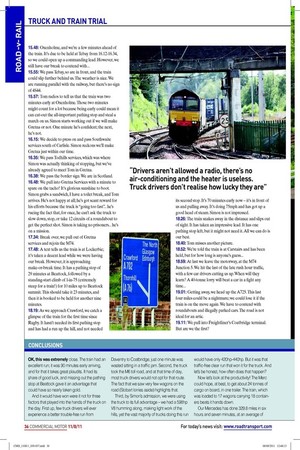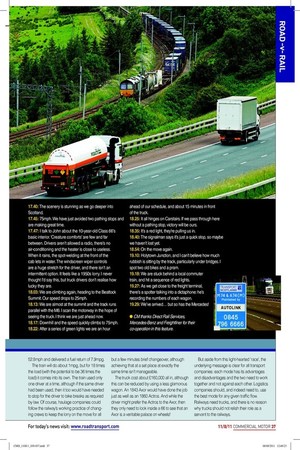CONCLUSIONS
Page 31

Page 32

If you've noticed an error in this article please click here to report it so we can fix it.
OK, this was extremely close. The train had an excellent run; it was 90 minutes early arriving, and for that it takes great plaudits. It had its share of good luck, and missing out the pathing stop at Beattock gave it an advantage that could have so nearly taken gold.
And it would have won were it not for three factors that played into the hands of the truck on the day. First up, few truck drivers will ever experience a better trouble-free run from Daventry to Coatbridge; just one minute was wasted sitting in a traffic jam. Second, the truck took the M6 toll road, and at that time of day, most truck drivers would not opt for that route. The fact that we saw very few wagons on the road (Stobart lorries aside) highlights that.
Third, by Simon’s admission, we were using the truck to its full advantage – we had a 598hp V8 humming along, making light work of the hills, yet the vast majority of trucks doing this run would have only 420hp-440hp. But it was that traffic-free clear run that won it for the truck. And let’s be honest, how often does that happen?
Now let’s look at the productivity! The Merc could hope, at best, to get about 24 tonnes of cargo on board, in one trailer. The train, which was loaded to 17 wagons carrying 18 containers beats it hands down.
Our Mercedes has done 329.8 miles in six hours and seven minutes, at an average of 52.8mph and delivered a fuel return of 7.9mpg.
The train will do about 1mpg, but for 18 times the load (with the potential to be 36 times the load) it comes into its own. The train used only one driver at a time, although if the same driver had been used, then it too would have needed to stop for the driver to take breaks as required by law. Of course, haulage companies could follow the railway’s working practice of changing crews to keep the lorry on the move for all but a few minutes brief changeover, although achieving that at a set place at exactly the same time isn’t manageable.
The truck cost about £160,000 all in, although this can be reduced by using a less glamorous wagon. An 1843 Axor would have done the job just as well as an 1860 Actros. And while the driver might prefer the Actros to the Axor, then they only need to look inside a 66 to see that an Axor is a veritable palace on wheels! But aside from this light-hearted ‘race’, the underlying message is clear for all transport companies: each mode has its advantages and disadvantages and the two need to work together and not against each other. Logistics companies should, and indeed need to, use the best mode for any given traffic flow. Railways need trucks, and there is no reason why trucks should not relish their role as a servant to the railways.














































